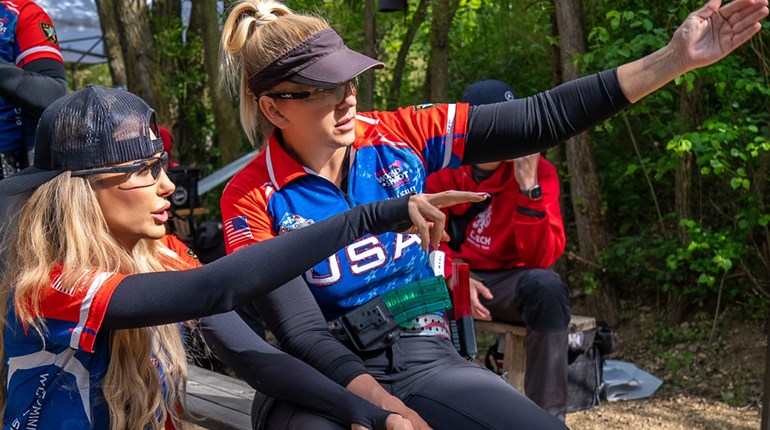
While range time is a great way to relax or spend time with friends and family, busy lives mean that it’s sometimes difficult to get to the range. What skills can you train at home without firing a round? Here are three that you can turn into part of a simple, ongoing, dry-fire training program.
1. Draw
Every time you use your firearm, whether it’s in competition or concealed carry, drawing the gun will be part of the process.
For competition, the draw relates to speed on a stage and a good draw sets the competitor up to have proper grip throughout the stage.
A draw for concealed carry is more important because if a person needs to use a firearm for personal defense, it’s a life-or-death scenario—and doing things correctly matters!
Here are a few aspects of the draw to pay attention to as you dry fire:
IMPORTANT: Before you start any dryfire session, remove your ammo and any magazines containing ammo, clear the gun, and put the ammo in another room. The reps that you can get in with dryfire are great, but don’t risk an accident. Have a dedicated spot and never bring ammo to that dryfire spot.
- The draw can be broken into steps. The steps will vary if you are drawing from concealment or a method of off-body carry, like a purse, but the essential elements are the same; you need to get the gun out of the holster and into the shooting position as fast as you can while establishing a proper grip. Read some different takes on the steps required to draw from both a holster without any concealment garments and from a holster while concealed. Then study how to draw from a purse or bag. Video yourself and work on the steps that give you trouble.
- Remember that it takes about 1,000 repetitions of any skill to develop something into a learned skill, and repetition creates the strongest form of learning. So don’t be afraid to spend 15 minutes a night just on your draw. You’ll be surprised by how many reps you get into 15 minutes.

2. Reload
While we generally use reloads only in specific places in competition, and try to never do one standing still (we call this a static reload, and it adds unnecessary time to the clock), reloads are a skill we must have. Being able to reload without looking down for your magazine is important in competition, but even more important in a self-defense scenario. A few points to remember to help you practice reloads with dry fire:
- Ensure that your magazine holder or reload mag is positioned in a way that you can get to it without looking for it. This might take some trial and error, but it’s necessary. Dryfire is the perfect place to do this. Do not waste live-fire training time with gear that has not been properly set up. Video yourself and your setup in action to see whether your configuration requires you to change your wrist angles or reach in any awkward way. Move things around and adjust until it’s fluid.
- Don’t lower your gun. Get used to hitting your mag release with your gun up, out in front, in your line of sight with your target still in your peripheral vision. Then your support hand should reach for and grab the magazine, and come up to the gun to seat it. You can rotate your gun and look at the magwell and think about “looking” your mag into the magwell. Then as you are seating it and pressing the gun back out into a shooting position, your focus returns to the target. The more you practice, the less focused on your mag and mag well you will be and the more you can focus on your target.
3. One-handed draw and first trigger pull
If asked to name a situation where you might have to use a firearm with one hand, most people would probably say one-handing shooting in a self-defense scenario. Drawing with one hand and pulling the trigger to see what your sights are actually doing with just that one hand can be humbling the first time you try. A few things to focus on as you practice this skill:
- Be very controlled and disciplined so that you establish a solid grip, high on the backstrap of the gun so that you can control recoil.
- Use a visual, some sort of target you aim at, and nothing too big. (I use the light switch plate on a wall). This will allow you to see movement in your sights as your finger pulls the trigger.
- Because you will put the trigger, you will have to reset the trigger each time you practice. But you could also just practice the draw until it’s comfortable, and then practice the draw and trigger pull both together.
- Focus on not involving your fingertips as you grip tightly and pull the trigger. Play with your grip and a “shaking hard” grip (gripping so hard your hand almost shakes), versus a grip where you focus on creating pressure between where your fingers are wrapped around the front of the grip and the meaty part of your thumb/palm on the back of the grip. It’s good to understand when you are gripping too much. Simply applying raw force isn’t always better. Technique and properly applied force is better.
- You can think about an imaginary string from the front sight to the ceiling, and as you draw and line up your sights to dry fire, pretend you're pulling down on that string. It will create tension that you’ll feel in your arm, shoulder, and lats that will help you control recoil.
Just a little time each day and some consistency will help you utilize the free tool of repetition to create strong skills that will make your next live fire range day more productive.













































